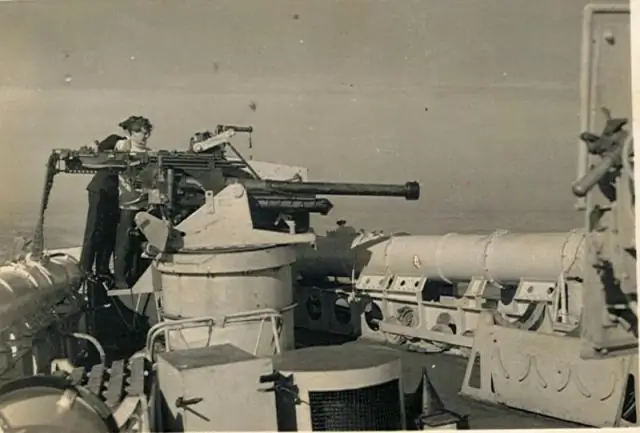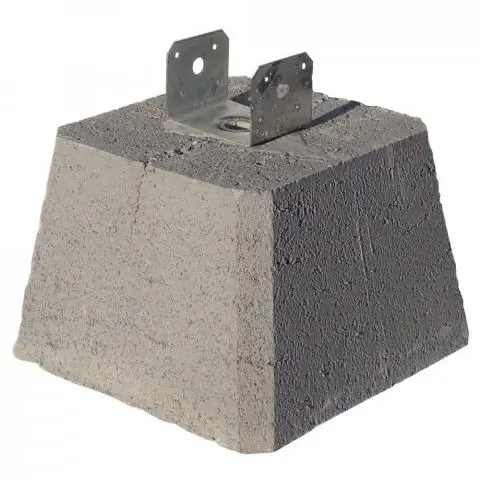
Table of contents:
- DIY steam generator and steam cannon
- Steam generator or steam gun - description, device, principle of operation, types
- Are there any fundamental differences between steam generators for baths, saunas and hamam
- Preparation for making a cannon for an open heater
- Steam gun for Finnish electric heater stove
- How to make a steam generator from a pressure cooker with your own hands
- Operating tips
- Author Bailey Albertson [email protected].
- Public 2023-12-17 12:53.
- Last modified 2025-06-01 07:32.
DIY steam generator and steam cannon

A home-made steam generator, or as it is called a steam gun, can serve as additional equipment for a bath stove, or it can be a separate device. Most often, such a device is used in a bath, sauna or hamam to generate a soft and therapeutic steam, created by adding aromatic herbs. A steam generator can be purchased at a specialized store, or you can do it yourself.
Content
-
1 Steam generator or steam gun - description, device, principle of operation, types
- 1.1 Device
- 1.2 Types and types
- 2 Are there any fundamental differences between steam generators for baths, saunas and hamam
-
3 Preparation for making a cannon for an open heater
- 3.1 The choice of material for creating a steam gun
- 3.2 Step by step instructions
-
4 Steam gun for the Finnish electric heater stove
4.1 Video: DIY steam gun
- 5 How to make a steam generator from a pressure cooker with your own hands
-
6 Operating tips
6.1 Video: DIY steam generator
Steam generator or steam gun - description, device, principle of operation, types
The healing properties of steam have been known for a long time, since it can have a healing effect on the human body if it is used in the optimal amount and at a certain temperature regime. If such a device is installed in the bath, then there is no need to regularly pour water on the stones in order for the required volume of steam to form in the steam room. Also, thanks to the steam gun, water is significantly saved. It does not take up much space, is easy to assemble and does not require a lot of expensive materials to create it.

Steam cannon for sauna stoves
Device
A traditional steam generator is a device that is equipped with an electric heating element. The principle of operation resembles an ordinary electric kettle. Pour water into the steam generator, turn on the heater, the liquid boils and steam forms. The cover of the device is equipped with a special valve, with which you can independently adjust the degree of pressure. As a result, we can independently "create" steam of the required temperature. Steam with a high degree of humidity will create the atmosphere of a traditional Turkish hammam, while hot and dry steam will make you feel like in a real Russian bath.

Furnace device with a steam generator
The steam generator can be used in conjunction with a stove - heater. As a result of this "contact", the steam produced by the device is additionally supplied to the stones for full heating. Thanks to this scheme, electricity is significantly saved and at the same time the temperature of the stones decreases, the load on the furnace decreases and its service life increases.
If you use a steam generator without a heater, the energy costs will increase significantly, but you will not need to build an expensive large brick oven. In this case, it will only be necessary to choose a heating system for the bath.
A typical store-bought steam generator consists of:
- Security sensor.
- Water tanks.
- Pump for moving water and steam.
- Preparatory block for water.
- Steam generation unit.
- Control panel.
Outside the device there is an indicator and a display that shows all information about the operation of the device and its programs.
Types and types
Such devices can have manual and automatic water filling. Automatic filling provides for the connection of the steam generator to the central water supply. Modern steam generators for the most part are equipped with an automatic system that will itself control the temperature in the steam room. And they can also be ceramic and metal.
There are two types of steam generators:
-
Industrial devices with voltages from 220 to 300 volts. Such devices are commonly used in large saunas and public baths.

Industrial steam generator Industrial steam generator for a bath
-
Household steam guns have a power of 4 to 16 kilowatts and are intended mainly for small domestic baths and saunas.

Household steam generators Household steam generators for baths, saunas and hamam
For a steam room of 10-13 m 3, a steam gun of 8-9 kW can be used. Indoors more than 15 m 3 it is recommended to install 12 kW devices. For a small steam room up to 5 m 3, it will be enough to make a 5 kW steam generator.
Devices that have a power of more than 9 kW have a three-phase connection system
Steam generators can have three types of water heating:
-
Electrode. In this case, the current passing through the electrodes through the water heats it up to a certain temperature. Such a heater has a simple design (ordinary metal rods act as electrodes) and does not overheat, since it simply will not work without water. But since the electrodes tend to dissolve over time, they will have to be periodically changed.

Electrode heaters Electrode heating elements
-
Heating elements. Devices of varying power levels are used to heat water.

Heating element TEN for heating water
-
Induction. The water is heated in the same way as in a microwave oven. In this case, the water is quickly heated, since the alternating electromagnetic field allows you to immediately heat the entire container in which the liquid is located.

Induction heater Induction heating element
Are there any fundamental differences between steam generators for baths, saunas and hamam
Many people are interested in the question, what is the difference between steam generators for a bath, a sauna or a hamam? Since all three types of structures are intended not only for washing, but also for improving the body, their action is based on the formation of steam. The difference between baths, saunas and hamam is the amount of steam produced, its temperature and humidity level.
Temperature conditions for different types of steam rooms:
- The Finnish sauna should be dry heat - the temperature ranges from 80 to 140 ° C, the humidity level is from 1 to 15%.
- In a Turkish hammam, there must be humid steam - the temperature is maintained at 45 ° C - the degree of humidity is 100%.
- In a Russian bath, steam should have an optimal humidity level from 50 to 80%, and the temperature should be maintained from 60 to 80 ° C.
The in-store steam generator, which has many modes of operation for generating steam, is suitable for all types of steam rooms. Using the remote control, you can independently set the temperature of the steam and its volume. Typically, such devices allow you to select temperatures up to 95 ° C. Also, industrial steam generators are equipped with special built-in programs that can independently create a certain temperature and volume of steam output, imitating a real Russian bath, Finnish sauna or Turkish hammam.
The steam generated by the steam cannon is softer and more gentle than pouring water onto hot stones. Thus, we can say that there are no significant differences in such devices, so they are suitable for any type of pair.

Sauna stove with steam gun
It should be noted that the raw steam, which is necessary for the hamam, is not too heavy for the human body, does not give the feeling of a suffocating atmosphere, since the room is heated only to a maximum high temperature of 45 ° C. And it is with the help of a steam generator that such a result can be achieved.
I would like to note that the modern Russian bath is not too different from the Finnish sauna in its design. Therefore, the amount of steam and its temperature in such steam rooms can be coordinated by the visitors themselves. With the help of a steam generator in any room of the steam room, you can create the conditions that are provided for a bath, sauna or hamam.
Preparation for making a cannon for an open heater
The main task in developing a blueprint for a steam gun is to ensure that the largest possible area of the iron water outlets is in contact with the stones in the furnace. The pipes must be placed as close as possible to stones heated to the maximum temperature.
It is very important to use the steam cannon in ovens where an open heater is installed. This is due to the fact that it is almost unrealistic to create good steam that would be suitable for steaming in a traditional sauna from a stove with stones. When water gets on stones, which are located in external places, located closer to visitors and further from the stove, it turns into a very wet, coarse-dispersion type steam.
Optimum comfort for people can only be created by dry steam, which is produced in the process of contact of water with the most hot parts of the furnace (the furnace itself and stones). It is not possible to fill the firebox with water, since it is separated from the bather by a large layer of stones, therefore, steam cannons were developed to efficiently deliver water.
The simplest solution was a steel pipe cannon, which is inserted into the free space of the stove, and then stones are simply laid.
Simple Steam Cannon Blueprint

Steam cannon drawing
The choice of material for creating a steam gun
We will make the simplest model of a steam gun, which does not require a large amount of expensive materials and at the same time it will be able to fully perform its functions.
Materials
- Corrugated pipe 2 pieces - diameter 4 mm.
- Corrugated pipes 2 pieces - smaller diameter.
- Open stove heater - model Shilka.
- Porcelain balls for setting in the oven.
- Metal funnel.
In order to make such a gun with our own hands, we only need a metal sharp object with which we will make holes in the pipe.
Step-by-step instruction
-
We take two corrugated pipes of the same size (selected depending on the size of the free space in the furnace). We make holes Ø 8-10 mm in them at the same distance from each other (about 5 cm). We bend their ends on both sides.

Corrugated pipes Corrugated pipes with holes
-
We place the pipes with the holes up at the bottom of the furnace. The folded ends should "point" up. We place both guns opposite each other.

The location of the pipe in the furnace The location of the pipe in the furnace with the holes up
-
We insert vertical pipes into the ends for water supply.

Insert a vertical pipe We insert a vertical pipe for water supply
-
We install funnels on top of the pipes so that it is convenient to pour water into them.

Funnel for filling water Insert a funnel for filling water
-
We take porcelain balls and completely fill the space of the oven with them, as shown in the figure.

Porcelain balls Porcelain balls for oven
-
Our simple steam generator is ready to use.

Steam cannon oven Complete oven with a simple steam cannon
Checking work
During the soaring period, such a steam cannon has shown its effectiveness. For 2.5 hours of "work" at a temperature of 65 to 95 ° C, 3.5 liters were poured in. water. This means that about 1.5 liters. water per hour was transformed into dry finely dispersed steam. After 2 hours, the temperature in the steam room remained stable at 80 ° C. This is enough for the steam room to have a comfortable temperature regime for the human body.
Steam gun for Finnish electric heater stove
In an electric heater at the bottom, the space does not heat up too much, so you can put a small vessel or container with holes there, which will be heated by heating elements and stones and boil water, creating the necessary steam.
Since the presence of heating elements and stones will not allow us to install a large container, we choose a copper pipe with special holes for steam outlet.
The stones around the tube warm up to 120-180 ° C, so the slowly evaporating water will provide the required amount of steam. Steam slowly passing through a 50 cm layer of hot stones will warm up to the optimum temperature, which is necessary for a steam room.

Finnish sauna stove electric heater
A thin copper tube will have a small heated mass from the relatively large volume of water passing through it and therefore will be able to cool quickly. Thus, in this design, there is no need to make a check valve. Its functions can be performed by the water itself, which is in the upper vessel.

Drawing of the vaporization process with a steam gun
Materials:
- Copper pipe with special steam vents - 1 inch diameter.
- Thin copper tube - 6 mm diameter.
- Steel funnel for water filling.
Tools
- Plumbing Soldering (95% Tin)
- Soldering iron
Assembling the structure of the steam gun
-
In order to simplify the task, we simply purchased a ready-made dispensing pipe with steam vents.

Dispensing tube with funnel Dispensing copper tube with funnel
-
We solder a long copper tube to one end of the dispensing tube. This must be done efficiently, since the device will be located almost at the bottom of a hot oven.

Welding the copper tube Welding the copper pipe to the end of the dispensing pipe
- We solder (or screw) a special funnel to the second end of a long pipe for water intake, into which water will be poured.
- In principle, our steam cannon is ready and all that remains is to put it in the electric heater.
-
To do this, we take out the necessary part of the stones from the oven and carefully lay the dispensing tube so that it lies between the heating elements. She had to bend it a little. The depth of the tube is about 60 cm.

We put the tube in the oven We put the tube in the oven between the heating elements, removing some of the stones
-
We take the pipe for filling the water up and then carefully put the stones back into the oven.

We fix the funnel We fasten the funnel to the end of the tube
-
Now you can turn on the electric heater and, after the stones are well warmed up, start pouring water into the funnel. Coming down the tube, water at boiling point will turn into steam, which will go out through the steam outlet openings and rise up.

Steam cannon oven Finnish oven with steam gun ready to use
If you add various medicinal decoctions or aromatic oils to the water, then the steam saturated with their aromas will fill the entire steam room

Aromatic essential oils for the bath
Video: DIY steam gun
How to make a steam generator from a pressure cooker with your own hands
Many craftsmen try to create useful things from the most common materials at hand. The steam generator, which is necessary in the bath, can not be purchased in the store, but simply made by hand. To do this, you need to perform the following actions:
- Choose a suitable dish.
- Mount the heating element.
- Organize the correct water flow.
- Take off steam.
- Check device.
Steam generator materials:
- Pressure cooker - 1pc.
- Electric heating heating elements.
- Plate.
- Studs, bolts, nuts and washers.
- Heat-resistant gaskets.
- Copper tube.
- Capacity for water.
- Float valve.
- Hose.
Tools
- Drill.
- Adjustable wrench.
Stages of work
- We install the heating element at a distance of about 1 cm from the bottom of the pressure cooker. At a certain height, we mark points on the outside of the pan and drill holes of the required diameter.
-
We prepare the holes for the installation of the heating element. To do this, we install a bolt and a hairpin in each of them, and string washers on both sides and clamp them with nuts as much as possible.

Preparing the heating element installation We drill a hole for the heating element
- Next, we need to make sure that the boiling water does not pass through the attachment points of the heating elements. For this we use seals made on the basis of sealed silicone. You can make them yourself.
-
We spread a sheet of paper on a flat surface and then apply sealant to it. We level it a little and put another sheet of paper and a piece of glass on top. We put any heavy object on top that will compress our workpiece. After the silicone has dried, we squeeze the gaskets out of it using a tube of the required diameter.

Making silicone gaskets We make sealed silicone gaskets
- We install heating elements and carefully tighten the nuts. Pour water into a container and make sure that there are no leaks.
-
We connect the power supply. To do this, under the heating element, we place a copper tube through which water will constantly flow. If we install a tube over a heating element, then we disrupt the entire process of vaporization.

We install the heating element Installing the heating element in the pressure cooker
- If water does not constantly flow into the steam generator, then the liquid in it will quickly evaporate and the device will fail.
-
Since water must constantly flow into the steam generator, and such a process cannot be carried out directly from the water supply, the following must be done. Install a vessel not far from the device, which will communicate with a copper tube supplying water. The height of the two vessels must be the same for the process to work. On the bottom of the second tank, we mount a float valve that will act as an intermediary between the steam generator and the vessel for supplying water. Such a faucet will "monitor" the water level and refill as it decreases.

Finished device Complete steam generator for steam generation
Bleeding off steam
After the steam generator is assembled, we need to learn how to choose steam from it. For this we select a hose of the required diameter. A hose from an old vacuum cleaner may work. We drill a hole in the lid and attach the adapter using a threaded connector.
It is important that the pressure cooker has a metal lid in which we can easily drill holes
Testing the steam generator
- In order to check the operation of the device, you need to make sure that both containers are completely sealed and do not leak anywhere.
- Check the water level.
- Connect the steam generator to the network and see how much steam the device produces.
Operating tips
- Steam guns of a simple design, which we considered in the first two options, do not require complex maintenance, since if there is no water in them, then steam simply will not be released.
- The steam generator has a heating element in its design, which, in constant contact with water, will "collect" scale on its surface. In order to increase the life of such a device, it is necessary to regularly inspect the heating elements and remove accumulated formations.
- It is recommended to install the steam generator not in a steam room, but in an adjacent room, so that the device is protected from contact with a humid environment.
Video: DIY steam generator
If a steam cannon is installed in your steam room, then you can be sure that in winter cold the room will heat up much faster and keep the heat for a long time. The main thing is to make such a device correctly so that it works effectively and can create a healing, saturated dry or wet steam necessary for a Russian bath, sauna or hamam. A self-made steam generator or steam cannon cannot fully replace modern factory settings, but if you do not need numerous additional functions, then you should opt for one of the homemade designs.
Recommended:
How To Make A Bar Stool With Your Own Hands From Wood, Metal And Other Materials + Drawings, Photos And Videos

Bar stools manufacturing options. Required tools, materials used. Step-by-step description of the manufacturing process with a photo
How To Make A Veranda With Your Own Hands To The House - Instructions, Projects, Drawings, Photos And Videos

The article describes how to build a veranda close to the house with your own hands
How To Make Lighting In The Bath With Your Own Hands (including In The Steam Room)

Detailed and step-by-step instructions for conducting electrical wiring and setting up lighting in bath rooms. Required materials, work features
How To Make A Long Burning Stove With Your Own Hands: Manufacturing Instructions With A Diagram And Drawings + Video

How to make a long burning stove with your own hands. Consumables, recommendations, diagrams, design features
How To Choose And Build A Foundation For A Bath With Your Own Hands - 4x6, 3x4 And Other Sizes, Tips, Instructions, Photos And Videos

How to make a foundation for a bath with your own hands. Types and features of foundations. The choice of materials and technology, installation rules and step-by-step instructions
